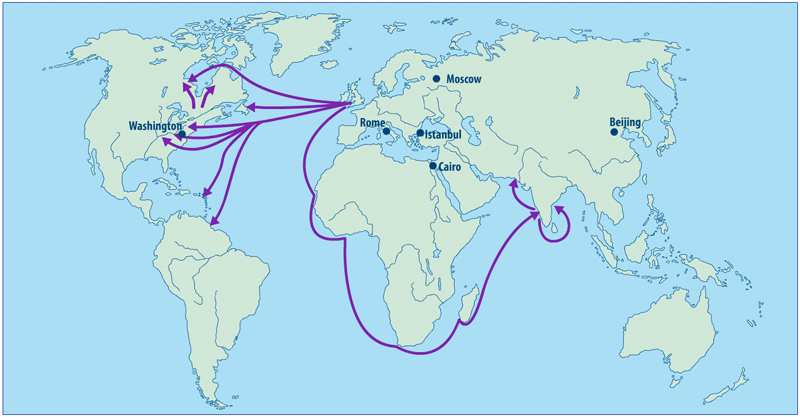Chapter 2 of class 8 history is “From Trade to Territory” explains the arrival of the British in India, the expansion of trade, the implementation of business rules, and the consequent acquisition of power by the British within the Indian Territory. In this blog, we bring the revision notes of the chapter “From Trade to Territory” to you.
Download Social Science Class 8 History Chapter 2 Important Questions and Answers PDF
Important Short Notes for Class 8 History Chapter 2
The Beginning of From Trade to Territory
After the death of the powerful Mughal ruler, Aurangazeb, many Mughal generals and subheaders started asserting and fighting for their power. However in the second half of the 18th century, the British rose to power in India, establishing dominion over every aspect of the Indian subcontinent, from trade to governance.
<div class="wp-block-image
East India Company Comes East
In 1600, the East India Company received a charter from the ruler of England, Queen Elizabeth I, for carrying out trade with the East. As per the statutes of the charter, the company could venture into newer places and purchase goods at a cheaper price and could sell them in Europe at higher prices. By then, the Portuguese had established a strong base on the western coast. Soon enough the Dutch arrived and started exploring the possibilities of trade in the Indian Ocean, followed by the French.
The British, Dutch, French and Portuguese were interested in cotton, silk, pepper, cloves, cardamom and cinnamon, which were high in demand. This led to fierce battles between the trading companies.
Are you liking our notes on From Trade to Territory? Let us know in the comment section below! Take a break from this topic and explore some of the most popular Indian National Movements here!
Trade-in Bengal
The first English factory was set up around 1651 from where the company’s base also known as “factors” operated. The goods for export were stored in the warehouse of the factory. The company built a fort around this settlement and constantly pressed for more concessions and privileges.
Trade Leading to Battles
With the increasing conflict between the Nawab of Bengal and the company, the nawab denied giving the company concessions, demanded tributes for the right to trade, and denied the right to mint coins. The nawab also claimed that the company was denying revenue and undermining the authority of the nawab. These confrontations ultimately culminated in the battle of Plassey.
The Battle of Plassey
After the death of Alivardi Khan in 1756, Siraj ud Daula was crowned as the Nawab of Bengal. The company tried to make one of the rivals of Siraj ud daula as the nawab of Bengal. On finding out about the strategy, the nawab asked the company to stop meddling in the political affairs and pay the revenue. Leading the company in 1757, Robert Clive waged a battle against the nawab in Plassey. Known as the Battle of Plassey, this became the 1st major victory of the nawab. The prime reason for the victory was that the battle was fought by the army of Mir Jafar.
The prime motive was the expansion of trade. The territory needn’t be taken over directly if conquest could be done with the help of the local rulers. But the company found it to be increasingly difficult. In 1756, the company was appointed as the Diwan of the provinces of Bengal. With the company getting access to the vast resources of Bengal, the trade expanded.
Before you move on to the next topic in the From Trade to Territory Chapter 2, here is an amazing blog on Indian Revolutions and their aftereffects for you!
Becoming of the Nabobs
The nawabs of Bengal were coerced to give land and vast sums of money as personal gifts after the battle of Plassey. Robert Clive along with many other officials made huge fortunes after coming to India. Many of them hailed from humble families and desired to make a great fortune in India and return to Britain to lead a comfortable life. Those officers who returned with immense wealth were called the nabobs- the anglicised version of nawabs.
Expansion of Company Rule
By employing a variety of political, economic and diplomatic methods the company launched a direct military attack on Indian territories. Many political or commercial agents were employed as residents in Indian states to work for the interests of the company. The company established a subsidiary alliance that meant Indian rulers were not allowed to have their independent armed forces and protected by the Company.
Tipu Sultan: Tiger of Mysore
Under the leadership of Haider Ali and Tipu Sultan, Mysore had grown in power. Controlling the trade-in Malabar coast, the Company purchased pepper and cardamom. In 1785, when Tipu Sultan stopped the trade of sandalwood, pepper and cardamom the company fought four wars with Mysore and achieved victory in the final battle of Seringapatam.

Claim to Paramountcy and Doctrine of Lapse
Under Lord Hasting, a new policy, of paramountcy was initiated due to which the company rose to immense power. Lord Dalhousie introduced the doctrine of Lapse wherein if an Indian ruler died without a male heir his kingdom would “lapse”, that is, become part of Company territory.
Under the guidance of Warren Hastings, the company expanded and acquired power in Bengal, Bombay and Madras and the British territories were broadly divided into administrative units called Presidencies.
The East India Company, therefore, transformed from a trading company to a territorial colonial power. By 1857, the East India Company had established control over 63 per cent of the territory and 78 per cent of the population of Indians.
NCERT Solutions for Chapter 2 From Trade to Territory The Company Establishes Power
Q.1. Match the following:
| Diwani | Tipu Sultan |
| “Tiger of Mysore” | Right to collect land revenue |
| Faujdari Adalat | Sepoy |
| Rani Channamma | Criminal Court |
| Sipahi | Led an anti-British movement in Kitoor |
Ans:
| Diwani | Right to collect land revenue |
| “Tiger of Mysore” | Tipu Sultan |
| Faujdari Adalat | Criminal Court |
| Rani Channamma | Led an anti-British movement in Kitoor |
| Sipahi | Sepoy |
Q.2 Fill in the blanks:
- The British conquest of Bengal began with the Battle of ___________.
- Haidar Ali and Tipu Sultan were the rulers of ___________.
- Dalhousie implemented the Doctrine of ___________.
- Maratha kingdoms were located mainly in the ___________ part of India.
Ans: a Plassey b. Mysore c. Lapse d. South-western
Q.3 What attracted European trading companies to India?
Ans: European trading companies came in search of new lands from which they could buy goods at a cheap price and carry them back to Europe to sell at higher prices. The fine qualities of cotton and silk produced in India had great value in Europe. Spices like Pepper, cloves, cardamom, and cinnamon were also in great demand and sold at a very high price. These were the reasons that attracted European trading companies to India.
Q.4 Describe the changes that occurred in the composition of the Company’s army.
Ans: The army of the company was known as the Sepoy Army. It mainly consisted of the peasants of India, trained by the EIC to become professional soldiers. The EIC army was dominated by infantry over cavalry with the introduction of muskets, and matchlocks to guard them. The soldiers were given European training through drills and other exercises.
Q.5 How did the assumption of Diwani benefit the East India Company?
Ans: Diwani rights are the rights by which the British collected their revenues and had the authority to decide on civil cases. This right led to East India Company benefit in many ways:
a. It allowed the Company to make use of vast revenue resources of Bengal
b. The monopoly of the East India Company on the trade commenced
c. Revenue of Bengal helped export Indian goods out of the country
Explore CBSE History Class 7 Notes
| Chapter 1: Tracing Changes through a Thousand Years |
| Chapter 2: New Kings and Kingdoms |
| Chapter 3: Delhi 12th to 15th Century |
| Chapter 4: The Mughal Empire |
| Chapter 5: Tribes, Nomads and Settled Communities |
| Chapter 6: Devotional Paths to the Divine |
| Chapter 7: The Making of Regional Cultures |
| Chapter 5: Tribes, Nomads, and Settled Communities |
FAQs
The army of the company was known as the Sepoy Army. It mainly consisted of the peasants of India, trained by the EIC to become professional soldiers. The EIC army was dominated by infantry over cavalry with the introduction of muskets, and matchlocks to guard them. The soldiers were given European training through drills and other exercises.
European trading companies came in search of new lands from which they could buy goods at a cheap price and carry them back to Europe to sell at higher prices. The fine qualities of cotton and silk produced in India had great value in Europe. Spices like Pepper, cloves, cardamom, and cinnamon were also in great demand and sold at a very high price. These were the reasons that attracted European trading companies to India.
Diwani rights are the rights by which the British collected their revenues and had the authority to decide on civil cases.
Follow Leverage Edu for more updates and interesting reads on School Education.
-
EXCELLENT WAY OF EXPLAINING THE CONCEPTS
-
Thank you for the feedback, Ritu!
We come out with regular blogs study notes and education materials so do sign up for our newsletter to get notified!
-

 One app for all your study abroad needs
One app for all your study abroad needs






















 45,000+ students trusted us with their dreams. Take the first step today!
45,000+ students trusted us with their dreams. Take the first step today!



2 comments
EXCELLENT WAY OF EXPLAINING THE CONCEPTS
Thank you for the feedback, Ritu!
We come out with regular blogs study notes and education materials so do sign up for our newsletter to get notified!